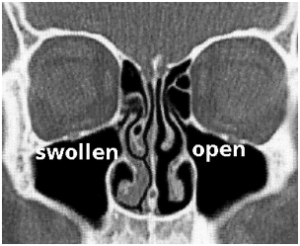Nadi Shodhana, or “alternate nostril breathing,” is a simple yet powerful technique that settles the mind, body, and emotions.
http://sequencewiz.org/2014/08/06/one-nostril-breathing/ BY OLGAKABEL
https://www.mindbodygreen.com/0-12936/3-reasons-everyone-should-try-alternate-nostril-breathing.html – Dr. Paula Watkins
https://chopra.com/articles/nadi-shodhana-how-to-practice-alternate-nostril-breathing – By Melissa Eisler
Conscious breathing exercises, or pranayama, are a big part of yoga, and they’re among the key tools I use as a psychologist — particularly when working with clients who are experiencing stress or anxiety. In Western contexts, diaphragmatic breathing is the most commonly known breathing technique but new scientific research is beginning to shed light on other pranayama techniques and their benefits.
Breathing consciously is a powerful act. The process of breathing sits directly at the interface of our voluntary nervous system (aspects of our physiology under our conscious control) and our autonomic nervous system (aspects generally not under conscious control). It’s a direct path for us to communicate quickly to the brain via what we do with our body. It also offers a direct link for balancing the sympathetic (fight-or-flight) and parasympathetic (rest-and-relax) branches of the nervous system.
Nadi Shodhana, or “alternate nostril breathing,” is a simple yet powerful technique that settles the mind, body, and emotions. You can use it to quiet your mind before beginning a meditation practice, and it is particularly helpful to ease racing thoughts if you are experiencing anxiety, stress, or having trouble falling asleep.
There are several different styles of Nadi Shodhana, but they all serve the purpose of creating balance and regulating the flow of air through your nasal passages. In fact, the term Nadi Shodhana means “clearing the channels of circulation.”
Nadi shodhana, or alternate nostril breathing, has a long history in Ayurvedic medicine and yoga, where it’s thought to harmonize the two hemispheres of the brain, resulting in a balanced in physical, mental and emotional well-being. While science has yet to really explore what might be going on in terms of hemispheric functioning during this practice, recent studies have confirmed some pretty powerful effects of this practice.
Benefits of Alternate Nostril Breathing
With just a few minutes of alternate nostril breathing, you can restore balance and ease in the mind and body. Sometimes when we feel frazzled or find ourselves doing too many things at once, it’s because energetically, we are out of alignment. This breath is great for restoring that necessary balance.
In addition to calming the mind and reversing stress, alternate nostril breathing also:
Improves our ability to focus the mind
Improves fine-motor coordination/performance
It enhances respiratory functions: increases respiratory strength and endurance.
Restores balance in the left and right hemispheres of the brain, and clears the energetic channels
Rejuvenates the nervous system
Removes toxins
Settles stress
Reduces blood pressure
So … nadi shodhana is good for our hearts; good for our lungs; and good for our heads.
Nadi shodhana and the parasympathetic nervous system

There is a predictable pattern of swelling and shrinkage in the nostrils that was first described (scientifically) by the German physician Richard Kayser in 1895. He had observed periodic cycles of congestion and decongestion that alternated between the right and left nostril, which was later termed “nasal cycle”. This phenomenon is widely known in the scientific community and has been subject to multiple studies. The funny thing is that yogis had known about it for hundreds of years and used it effectively to change the body’s temperature and one’s mental state, but we’ll get to that later.
Here is what science confirmed so far:
1. At any given moment you are breathing through one dominant nostril; then some time later you switch to another one. This switch happens every 2-2.5 hours (although it can vary), and continues in a rhythmical fashion.
2. This rhythm changes over time for most people.
3. It seems to be controlled by the central nervous system.
4. Swelling and shrinking seems to be related to sympathetic (SNS) and parasympathetic (PNS) nerves.
Most organs in the body (including cerebral hemispheres) are innervated by fibers from both SNS (fight-or-flight) and PNS (rest-and-digest). There are a bunch of those nerves in the nose, too. We have one set of the nerves that covers the right side of the body and the right nostril, and another one that covers the left side and the left nostril. What scientists are finding now is that those fibers have opposing effects. This means that at any given moment you have sympathetic dominance on one side of the body (and breathe mostly through that nostril) and parasympathetic dominance on the other. Then some time later they switch. This is called “lateralized ultradian rhythms of the ANS”. So basically the nasal cycle is an indicator of the switch that happens between the SNS and PNS from one side to another.
Why does it matter? Well, multiple research studies show that the way your body functions is quite different based on which side of the body has sympathetic dominance. Here is what it looks like:
When the sympathetic system is dominant on the right side and parasympathetic system is dominant on the left, you get:

Right nostril dominance
Right lung dominant
Generally more active state
Locomotor activity increased
Heart rate increased
Blood pressure increased
Respiration rate increased
Body temperature increased
Cortisol increased
Prolactin secretion reduces
Testosterone increased
Endorphins increased
When the sympathetic system is dominant on the left side and parasympathetic system is dominant on the right, you get:

Left nostril dominance
Left lung dominant
Generally more resting state
Locomotor activity decreased
Heart rate reduced
Blood pressure reduced
Respiration rate reduced
Body temperature reduced
Cortisol reduced
Prolactin secretion increased
Testosterone reduced
Endorphins reduced
So basically in the course of the day you alternate between more active and more restful states, which is confirmed by a widely accepted BRAC hypothesis (basic rest-activity cycle).
Yogis arrived at a similar discovery a while ago, though they have used different language to describe it. They said that our energy balance is affected by the flow of energy along three major channels: ida, pingala and sushumna nadis. Ida (lunar channel) is cooling and has overall feminine quality; it terminates at the left nostril. Pingala (solar channel) is heating and has an overall masculine quality; it terminates at the right nostril.
Breathing in through a nostril will emphasize the qualities of that channel; breathing out through the nostril will sedate the corresponding channel. This model is used widely in a therapeutic context.
Sometimes there might be too much heat in the system (for example, if somebody has hot flashes or feels angry/irritable), which can be helped by breathing in through the Left nostril (to stimulate the lunar channel) and out through the right (to sedate the solar chanel). This pranayama practice is called Chandrabhedana.
When there is not enough heat in the system (for example, cold limbs, low blood pressure, depression), it can help to breath in through the Right nostril (to stimulate the solar channel) and out through the Left (to sedate the lunar chanel). This pranayama practice is called Suryabhedana.
According to the tradition, when two sides are balanced, prana can enter the central channel – sushumna nadi – and travel upwards to the top of the head. Then eternal bliss (samadhi) is achieved.
Another interesting fact: traditionally, when you breathe through one nostril or the other, you don’t leave it completely open, but rather valve it right next to the bony part of the nose, so that the opening is narrowed and a sort of vibration is achieved. We have mentioned earlier that there are many nerve branches of the autonomic nervous system in the nose, so may be valving the nose was meant to better stimulate the corresponding branch of the nervous system (SNS or PNS) and facilitate more pronounced energetic effect? One wonders. It certainly helps you make your breath cycle longer. You can try it for yourself, too. Next time you try one nostril breathing, try valving the nostril that you are breathing through – it is a very different experience.
Whether you’re nervous about a project or presentation, anxious about a conversation, or just generally stressed out, Nadi Shodhana is a quick and calming way to bring you back to your center. If you find it difficult to settle into your meditations, try moving through a few rounds first, then remain seated and shift directly into stillness; this should help to ground you before meditation.
Nadi Shodhana Practice
Next time you find yourself doing too many things at once, or you sense panic or anxiety begin to rise, move through a few rounds of alternate nostril breathing. It’s a great way to hit the reset button for your mental state.
Sit in any comfortable seated position. Relax the body and breath naturally for a few moments, allowing your mind and body to settle.
Rest your left hand on your lap or knee.
Make a “peace sign” with your right hand. Fold the two extended fingers toward the palm or rest them lightly on the bridge of your nose. Place your thumb gently onto your right nostril. Place your ring and little fingers gently onto your left nostril.
Close your eyes and begin by softly closing your right nostril (using your right thumb) and inhale slowly, deeply, smoothly, gently and without strain through your left nostril.
Close your left nostril (using your ring and little fingers) and release closure of your right. Exhale through your right nostril. Inhale through your right nostril.
Close your right nostril and release closure of your left. Exhale through your left nostril.
This completes one round. Continue the pattern from steps 4-7 for as long as you wish. When you’re finished: relax both arms, sit and breathe naturally for a few moments before opening your eyes.
If you’re moving through the sequence slowly, one cycle should take you about 30-40 seconds. Move through 5-10 cycles when you’re feeling stressed, anxious, or in need of a reset button.
Tip: Consistency is helpful, so try to match the length of your inhales, pauses, and exhales. For example, you can start to inhale for a count of five, hold for five, exhale for five, hold for five. You can slowly increase your count as you refine your practice.

